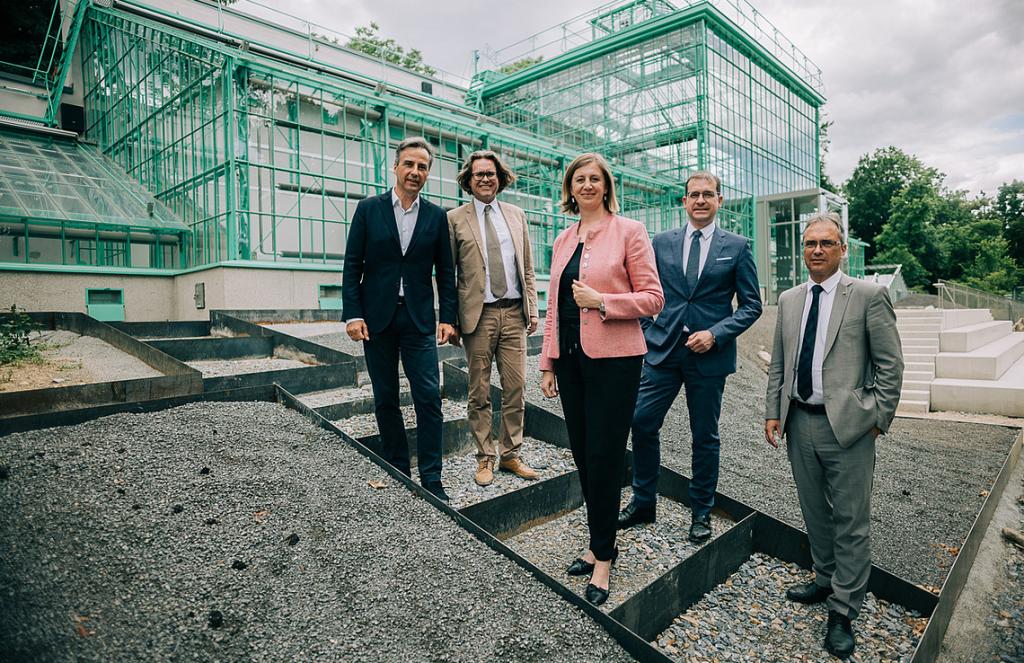Thessaloniki gets ready for its metro launch in November
The underground rapid transit lines have been under construction for almost two decades due to various project delays
 TheMayor.EU logo
TheMayor.EU logo 
L-R: Mayor Siegfried Nagl, Rector Martin Polaschek, State Councilor Barbara Eibinger-Miedl, CEO of BIG Hans-Peter Weiss and Vice Rector Peter Riedler, Source: University of Graz / Kernasenko
A total of 530 square meters will be used for public gatherings and science experiments
The renovation of the old greenhouse in the Botanical Garden of the University of Graz has been completed on 5 July 2021. The building is more than 130 years old and is the only surviving example of university glasshouse architecture from the late 19th century.
The University of Graz Rector Martin Polaschek welcomed Mayor Siegfried Nagl and Hans-Peter Weiss, Managing Director der Bundesimmobiliengesellschaft (one of the largest estate owners in Austria), for the first look at one of the jewels of the campus. The renovated greenhouse will now be used as a public gathering space and will be open to the public officially in September.
The Botanical Garden was erected in 1889 by the Viennese kk iron construction workshop Ignaz Gridl - active during the period of the Austro-Hungarian monarchy. Initially, it housed the plants from an even older botanical garden in the city that was demolished in the 1880s.
Later on, in the 1990s, a cultural initiative saved the ageing glass and iron architecture piece at the last second from complete dismantling, and in 2008 the historic core building became a protected site.
Today the area of the Botanical Garden covers around 2.9 hectares and, with 7,400 plant species, is home to around three times as many species as there are in Austria's “wilderness”, according to ORF.
Considering the building's long and unique history, great attention to detail was paid so the renovation was done without disrupting the historical integrity of the site. One example is the steel framing painted in the original colour green from 1889, typical for these types of botanical gardens.
In the end, the project’s costs amounted to 3.8 million euros, co-funded by the city of Graz and the state of Styria, as well as BIG and the University.
After the renovation, a total of around 530 square meters will be available for public and scientific use. The property will be used for plant cultivation, university exercises and lectures as well as for scientific events and forums. Some of the building’s wings were upgraded with research stations while other special experimental areas were created for science.
Furthermore, the architectural focal point - the palm house - will serve as a university meeting place and multifunctional event location while the design of the outdoor area of the park will be ready by mid-August.
Bundesimmobiliengesellschaft(BIG), the company that maintains the glasshouse, owns a total of 200 university properties in Austria, ranging from the Renaissance to the most modern university campuses. This is why Hans-Peter Weiss, the CEO, stressed the need for careful and consistent preservation of Austria’s architectural culture and legacy.
At the same time, Graz Mayor Siegfried Nagl was quoted in a press release saying: “To revive this architectural gem and to use it sustainably for university purposes is an upgrade for the science city Graz! The cooperation on listed buildings with the University of Graz has produced many positive examples in the past.”
If you want to keep up with how European cities and regions are changing, follow us on Facebook, Twitter and Instagram.

The underground rapid transit lines have been under construction for almost two decades due to various project delays

Now you can get your wine in Talence by paying directly in Bitcoin

That’s because the state has to spend money on updating the railway infrastructure rather than subsidizing the cost of the popular pass

Rethinking renewable energy sources for the urban landscape

The examples, compiled by Beyond Fossil Fuels, can inform and inspire communities and entrepreneurs that still feel trepidation at the prospect of energy transition

Now you can get your wine in Talence by paying directly in Bitcoin

The 10th European Conference on Sustainable Cities and Towns (ESCT) sets the stage for stronger cooperation between the EU, national and local level to fast track Europe's transition to climate neutrality.

At least, that’s the promise made by the mayor of Paris, Anne Hidalgo

The underground rapid transit lines have been under construction for almost two decades due to various project delays

At least, that’s the promise made by the mayor of Paris, Anne Hidalgo

Hostal de Pinós is located in the geographical centre of the autonomous region

Despite its church-y name, the district has long been known as the hangout spot for the artsy crowds

Urban dwellers across the EU are having a say in making their surroundings friendlier to people and the environment.

Forests in the EU can help green the European construction industry and bolster a continent-wide push for architectural improvements.

Apply by 10 November and do your part for the transformation of European public spaces

An interview with the Mayor of a Polish city that seeks to reinvent itself

An interview with the newly elected ICLEI President and Mayor of Malmö

A conversation with the Mayor of Lisbon about the spirit and dimensions of innovation present in the Portuguese capital














